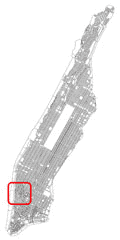|
|
Paintings:
The above map indicates the locations that formed of the basis for some of the great paintings that have been produced with focal points in the West Village and SoHo. The red line is a suggested walking tour to view the locations that created the backdrops for the great paintings produced in Greenwich Village and SoHo.
|
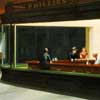 |
1. Nighthawks, Edward Hopper, based on Building that stood at SE corner of 7th Avenue and Greenwich Avenue
The most well known of Hopper's paintings, Nighthawks (1942), shows customers sitting at the counter of an all-night diner. The diner's harsh electric light sets it apart from the dark night outside, enhancing the mood and subtle emotion of the painting. The painting conveys the elements of confinement and isolation. One critic, Walter Wells, sees in the picture the influence of Ernest Hemingway's story, "A Clean, Well-Lighted Place," both picture and story representing a "sanctuary against the ultimate night [i.e. death] in a world without God or spiritual solace."
|
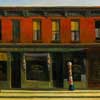 |
2. Early Sunday Morning, Edward Hopper, 233-237 Bleecker Street
With the recently renovated space downstairs containing an ice cream parlour with long lines in the summertime, it's hard to imagine the connection between this busy corner and the one in Hopper's painting. But if you look to the second floor windows, practically untouched from years ago, it's unmistakable.
|
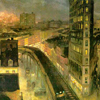 |
3. The City from Greenwich Village, John Sloan, Lower 6th Avenue near Cornelia Street
John Sloan, once a newspaper illustrator in Philadelphia, became a painter at the urging of Robert Henri and moved to New York. The apparent spontaneity in Sloan's City from Greenwich Village (1922) is deceptive. Noting it was "painted from memory". Since that shimmering vision actually would not have been visible from this low level, the skyline derives from other studies done at higher elevations. Sloan described the personally meaningful site: "Looking south over lower Sixth Avenue from the roof of my Washington Place studio, on a winter evening. The distant lights of the great office buildings downtown are seen in the gathering darkness. The triangular loft building on the right had contained my studio for three years before."
|
 |
4. Sixth Avenue Elevated at Third Street, John Sloan, 6th Avenue and 3rd Street
|
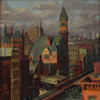 |
5. Jefferson Market, John Sloan, Sixth Avenue and 3rd Street
John Sloan painted Jefferson Market in various lights and from many angles. In this 1917 version he rotated the canvas and shows much more of the elevated train running along Sixth Avenue, and takes the view from above in order to show more of the overall village.
|
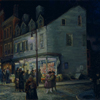 |
6. Bleecker Street, Saturday Night, John Sloan, Bleecker Street at Seventh Avenue.
During the second decade of the 20th century, Seventh Avenue was extended south below Eleventh Street and thereby slashing a path through the existing buildings of Greenwich Village. In the painting Bleecker Street, Saturday Night (1918), John Sloan shows the abrupt ending of an old federal-period clapboard building whose rear appears to have been sheared off.
|
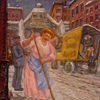 |
7. Maid Cutting Ice, John Sloan, West 8th Street and Sixth Avenue.
Sloan witnessed the scene in his painting Maid Cutting Ice (1918) on his way to Mrs. Gertrude Vanderbilt Whitney's Greenwich Village studio. At the studio, Mrs. Whitney gave the invited artists art supplies, whiskey, and cigars and requested that they paint something within five days. This was the painting Sloan created. The results were hung in Mrs. Whitney's Indigenous Exhibition. Having been created in the studio, these works were considered to be "indigenous."
|
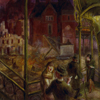 |
8. The Fall of the Village Bastille, John Sloan, Sixth Avenue at Greenwich Avenue.
The painting The Fall of the Village Bastille (1929) chronicles the changing landscape of Greenwich Village. In the foreground men and women watch from the elevated station on Sixth Avenue as the women's prison behind Jefferson Market is razed.
|
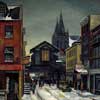 |
9. Christopher Street, Greenwich Village, Beulah R. Bettersworth, Christopher at Bedford Street
The painting Christopher Street, Greenwich Village (1934) captures the essence of the far west village in the 30's during a snow storm. The painting is a view looking west along christopher from the intersection at Bedford Street. Note that the entrance to the Hudson Tunels (the path station) on the right hand side is the same today, yet the elevated subway beyond, was torn down years ago.
|
|
|
|
|
|
|
|

